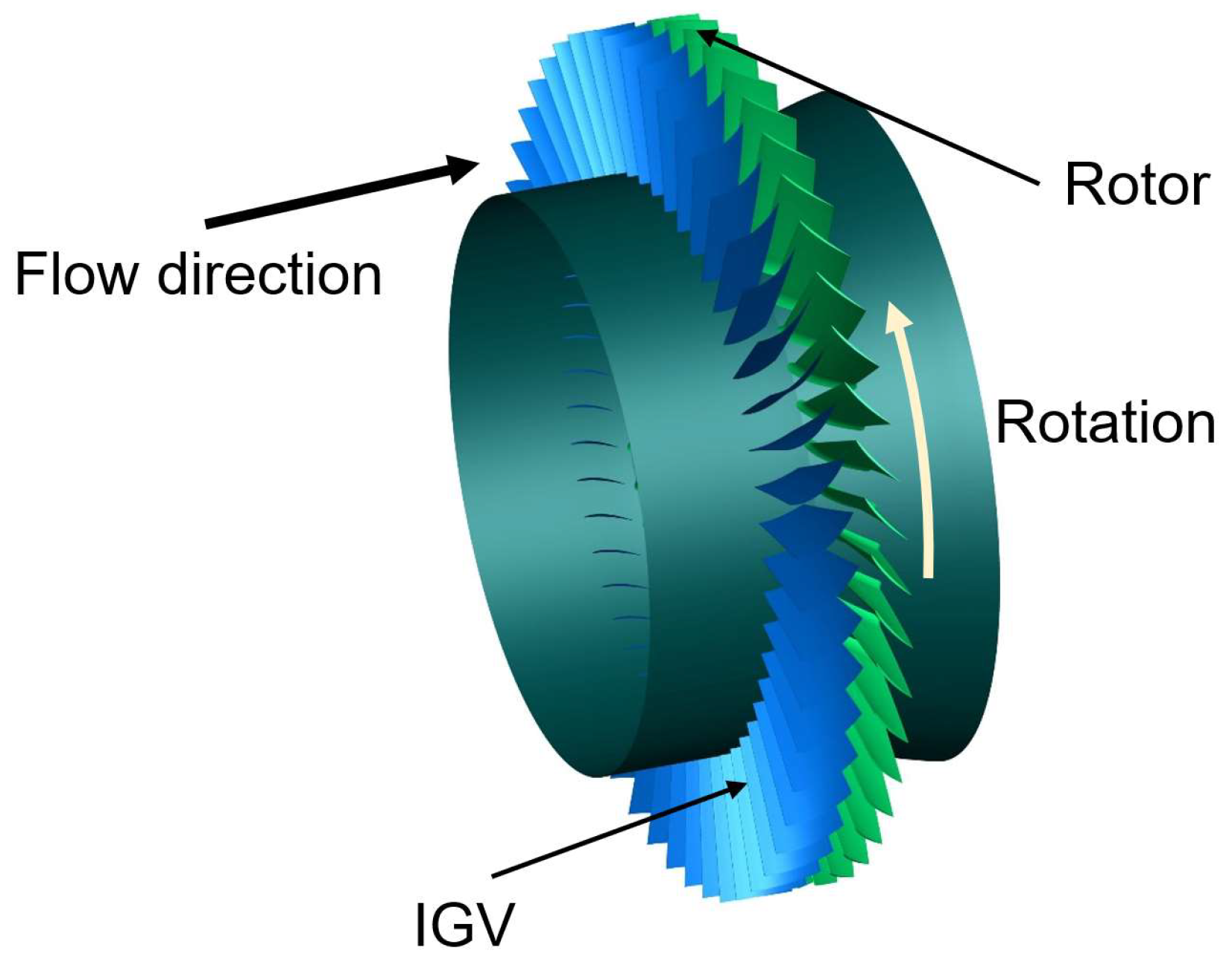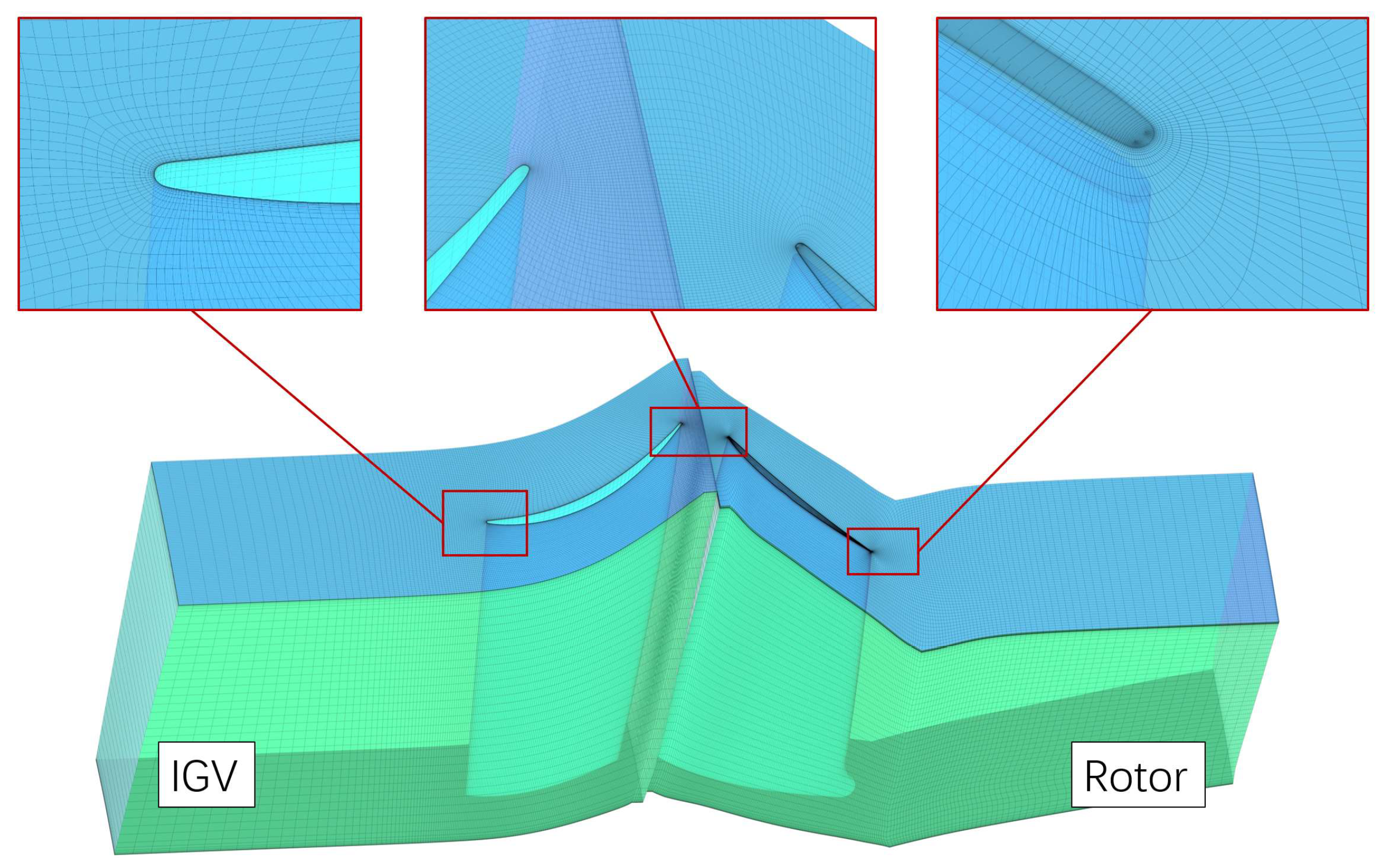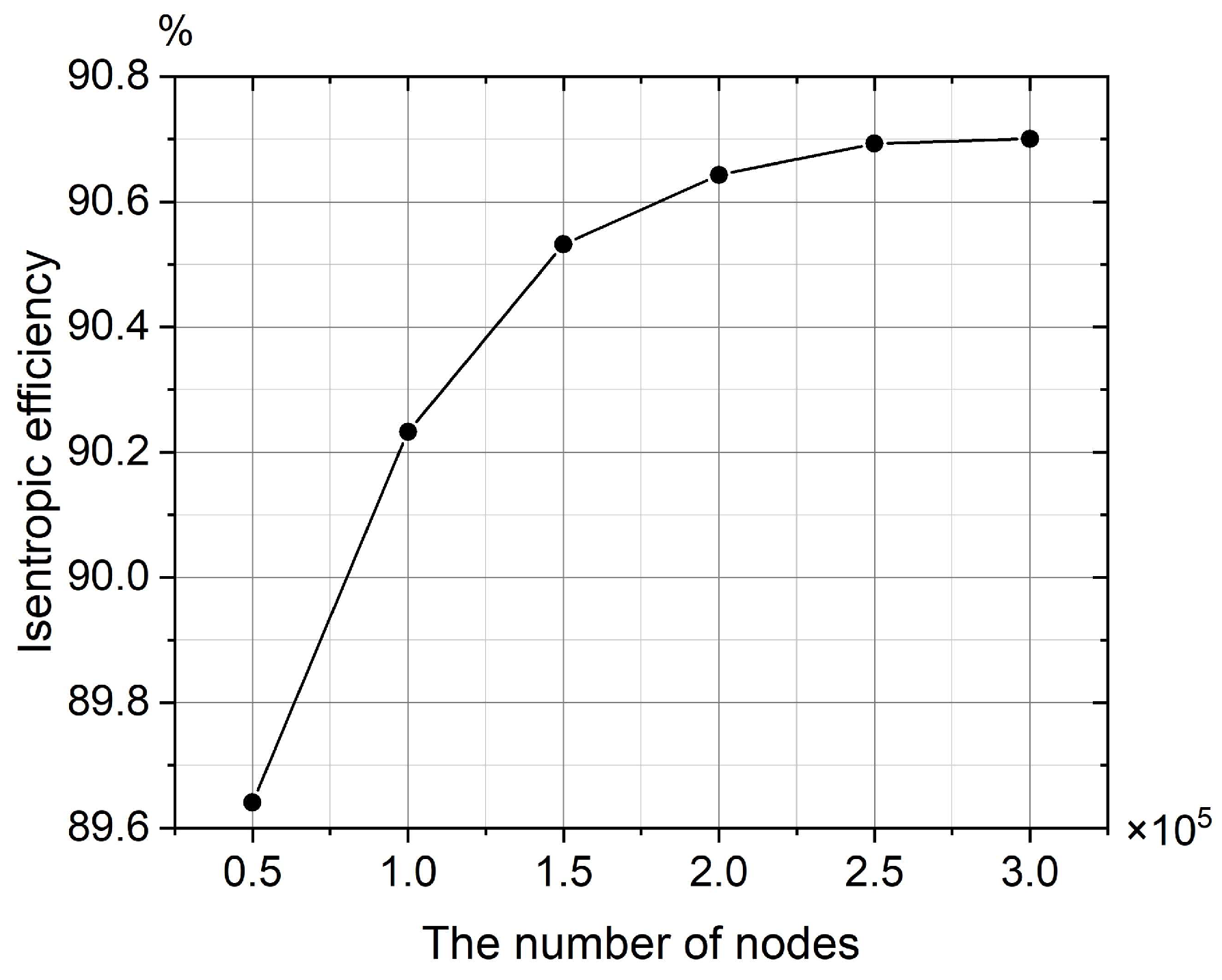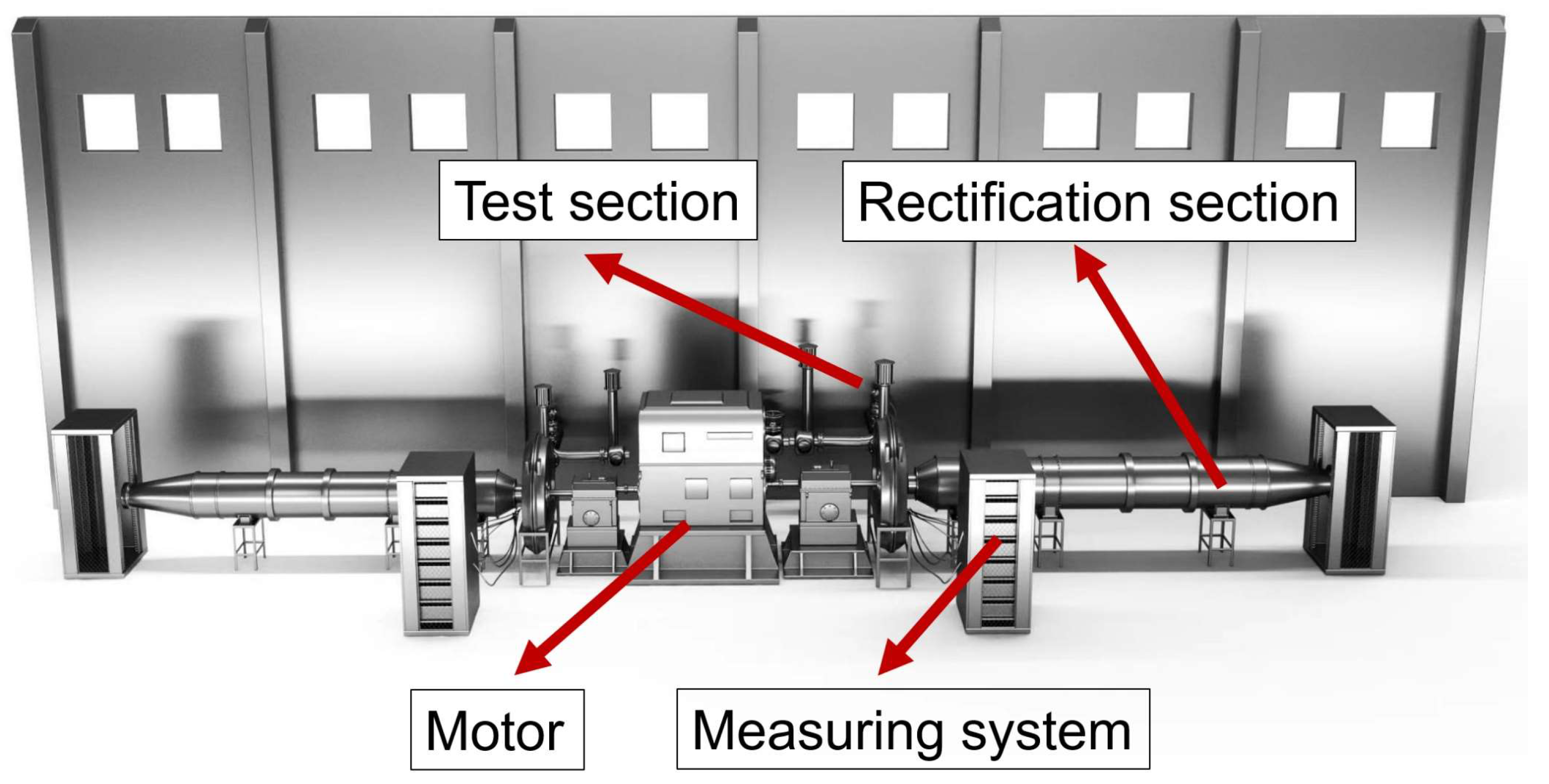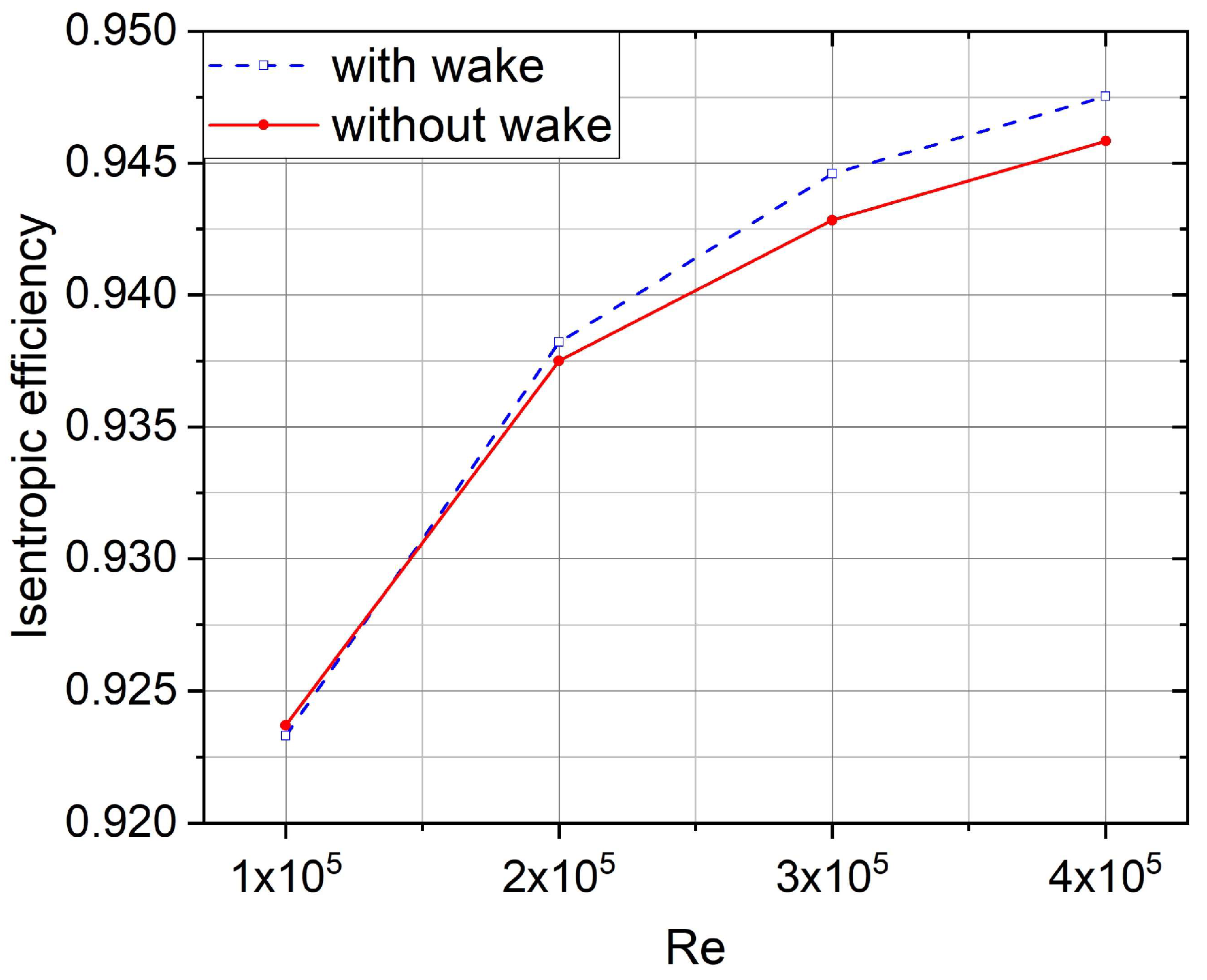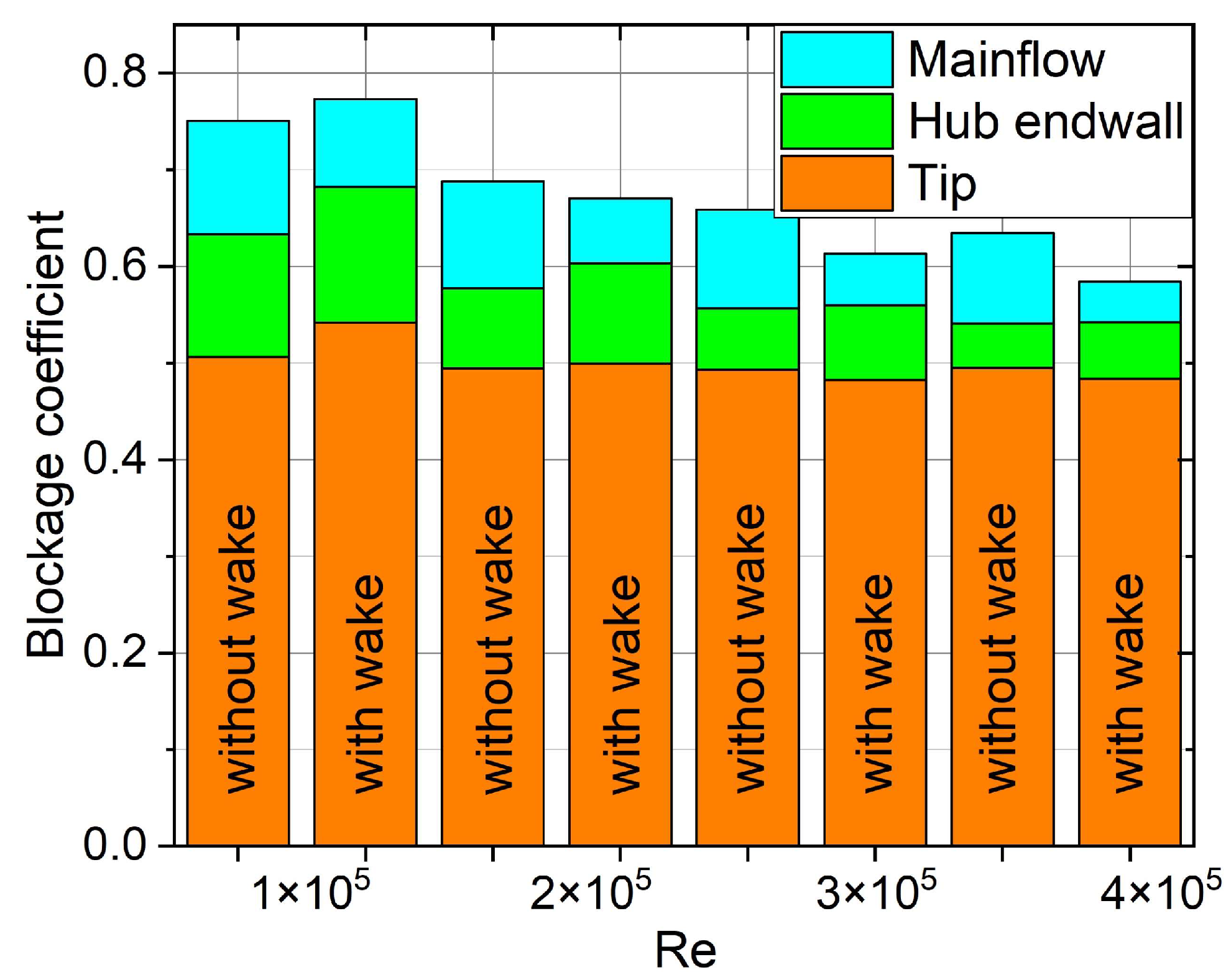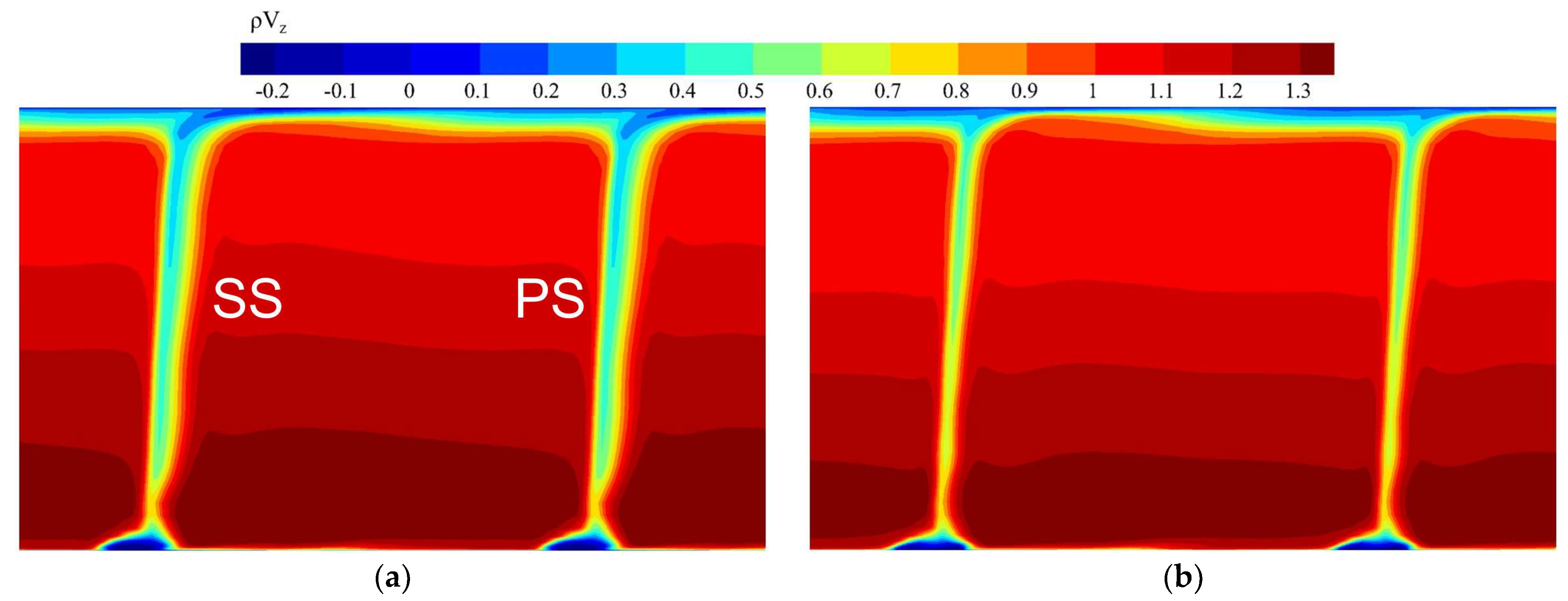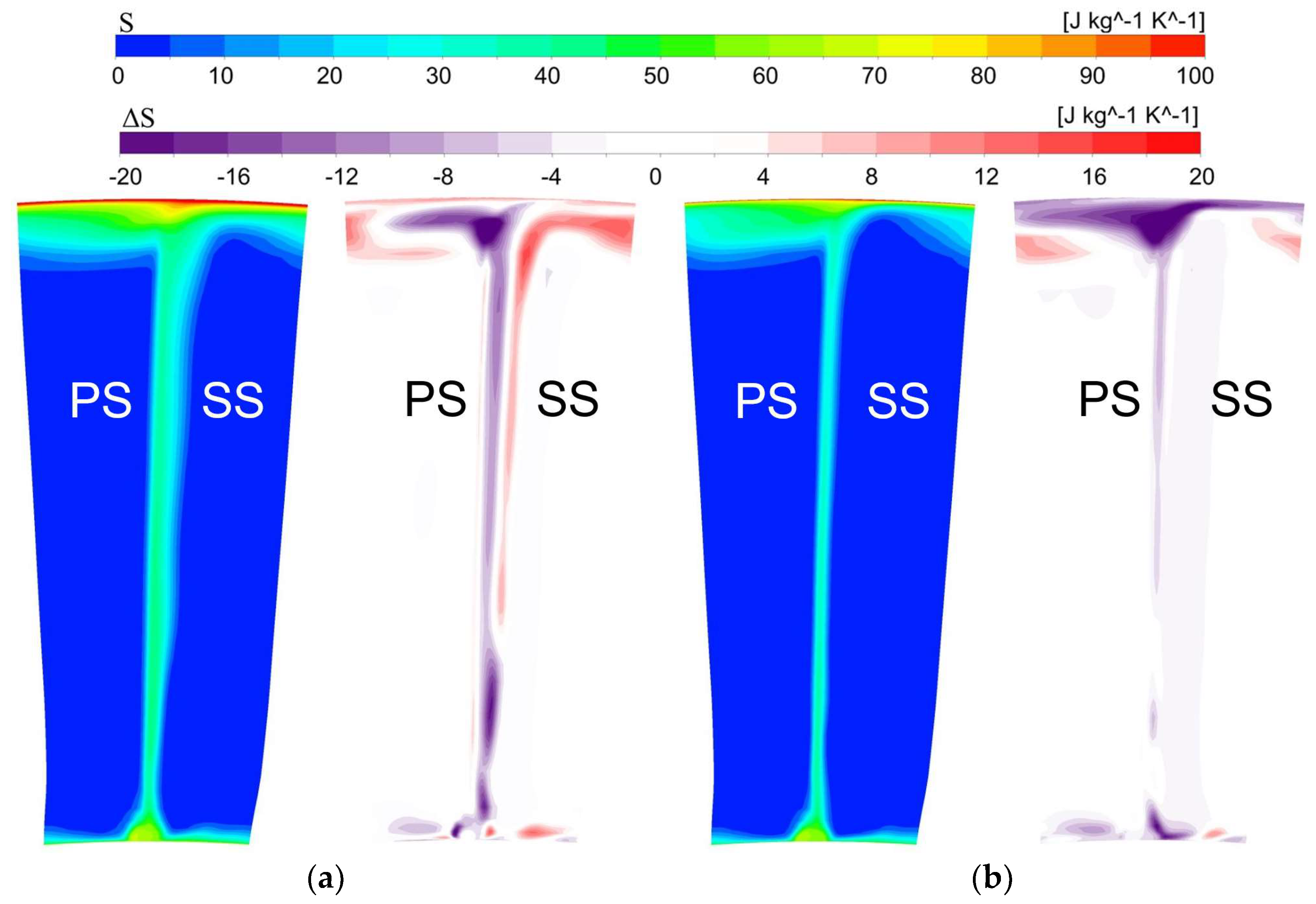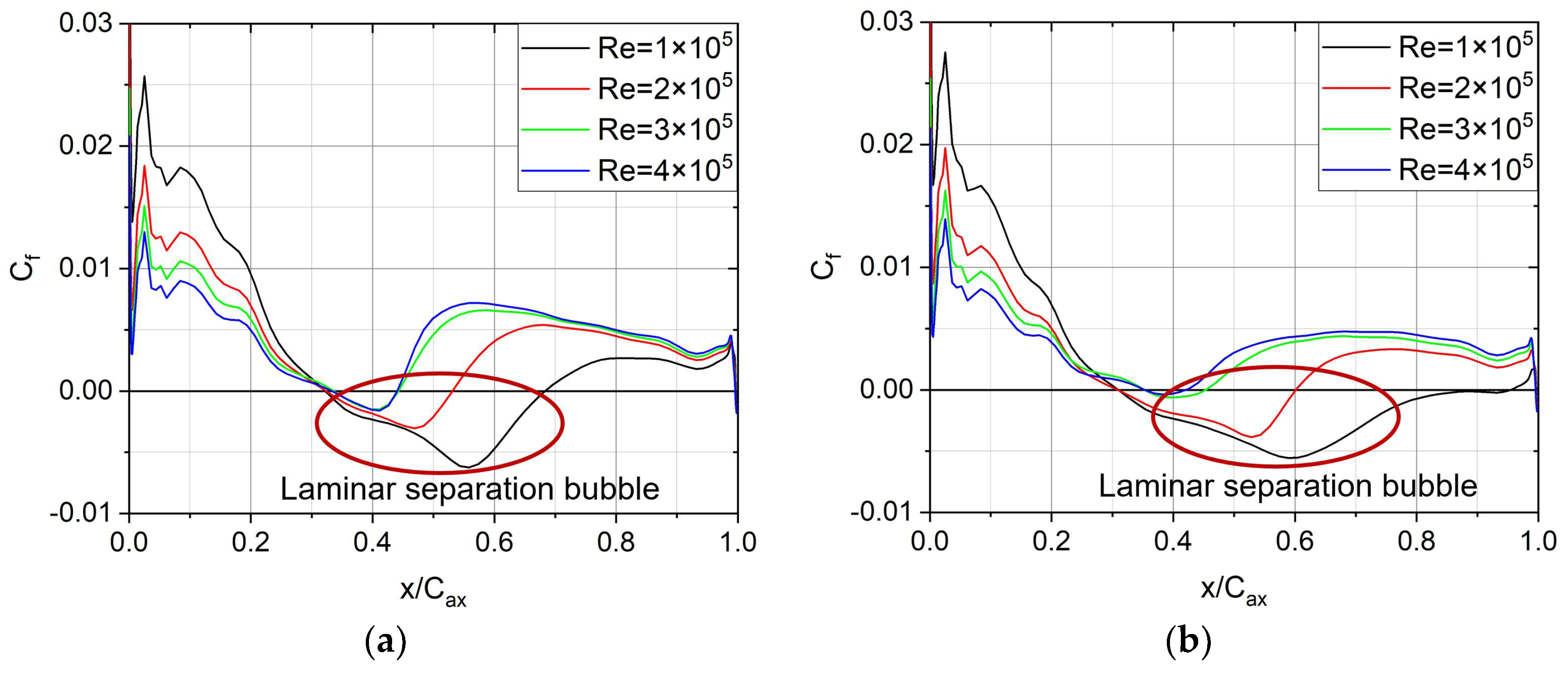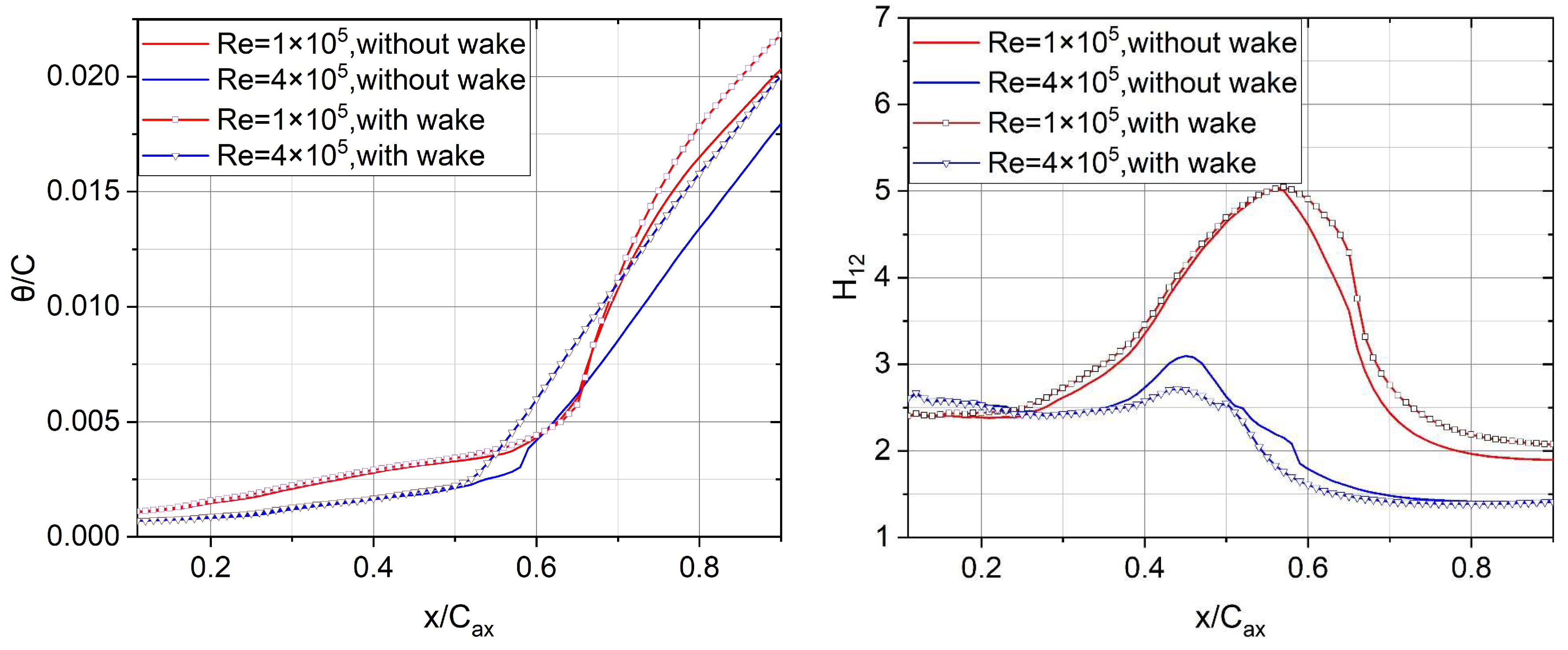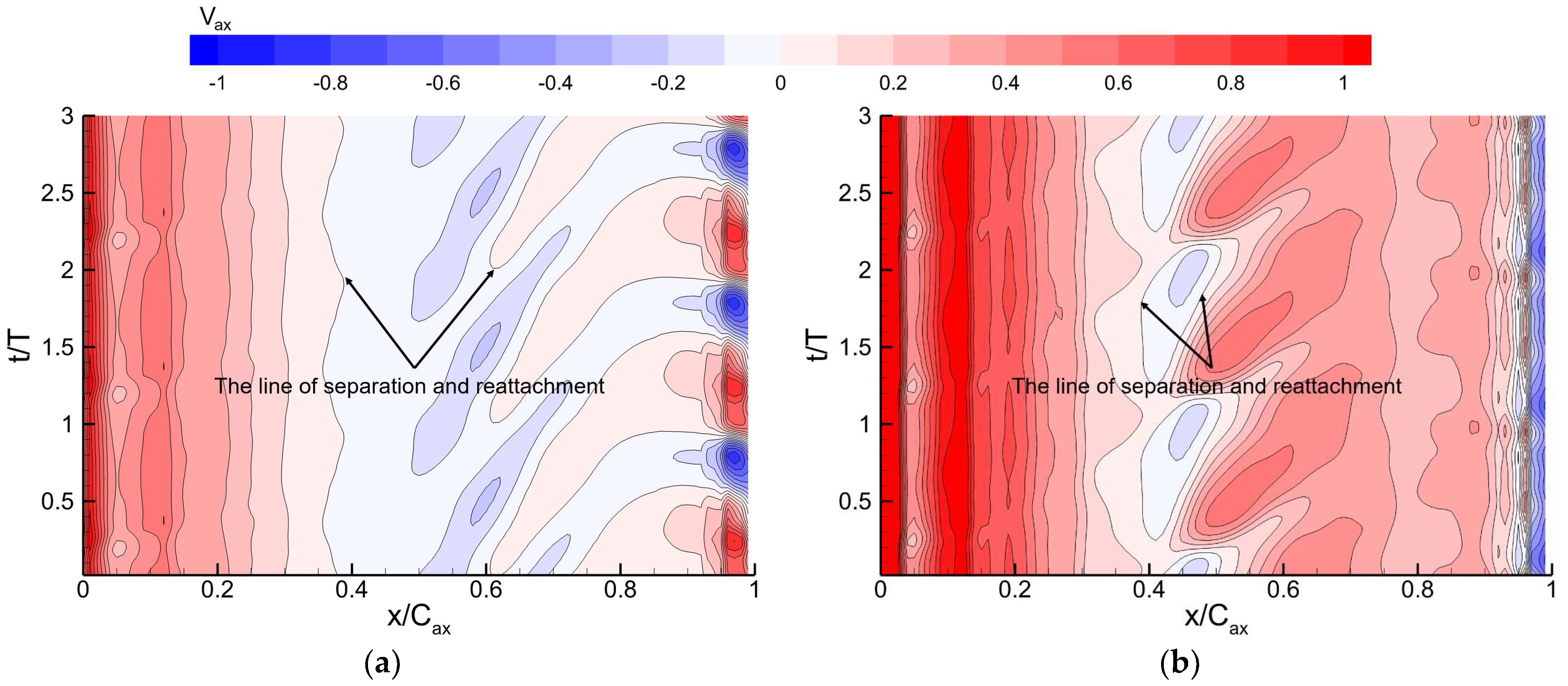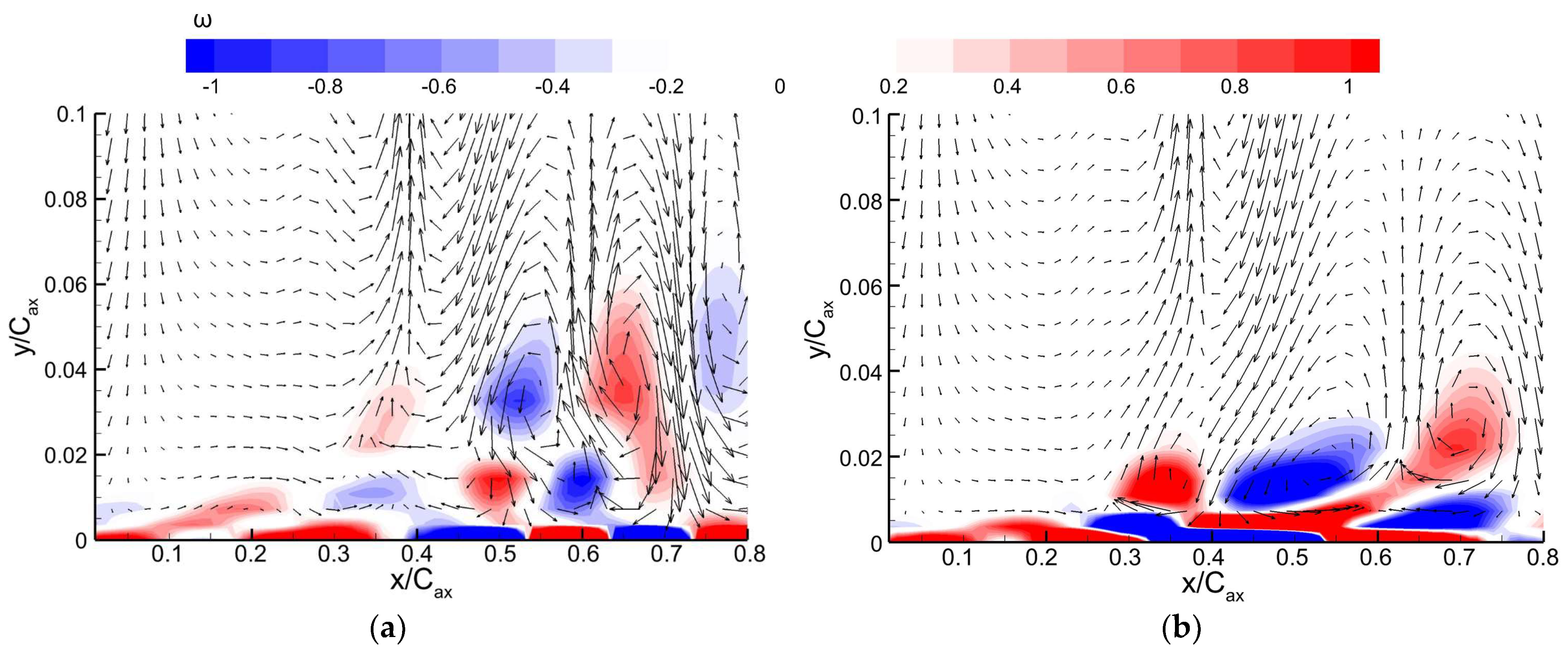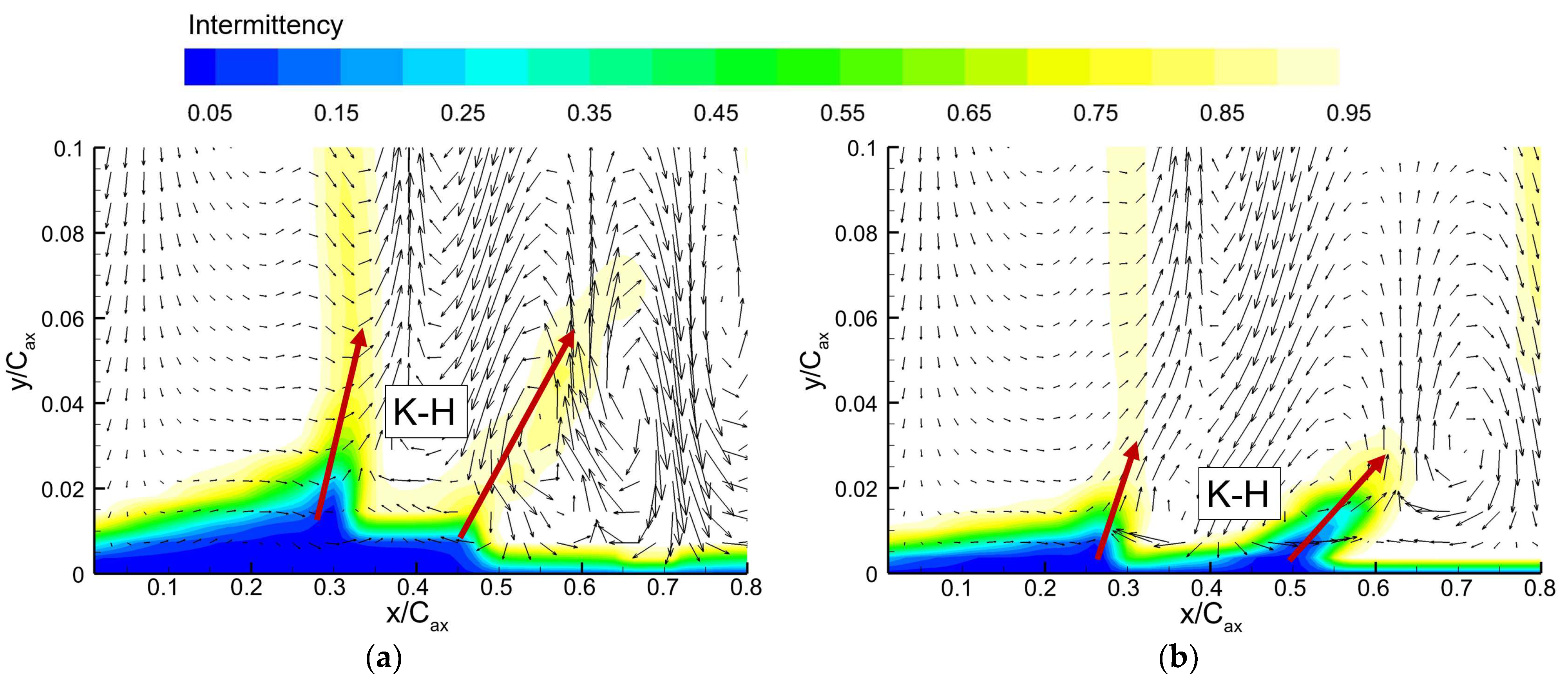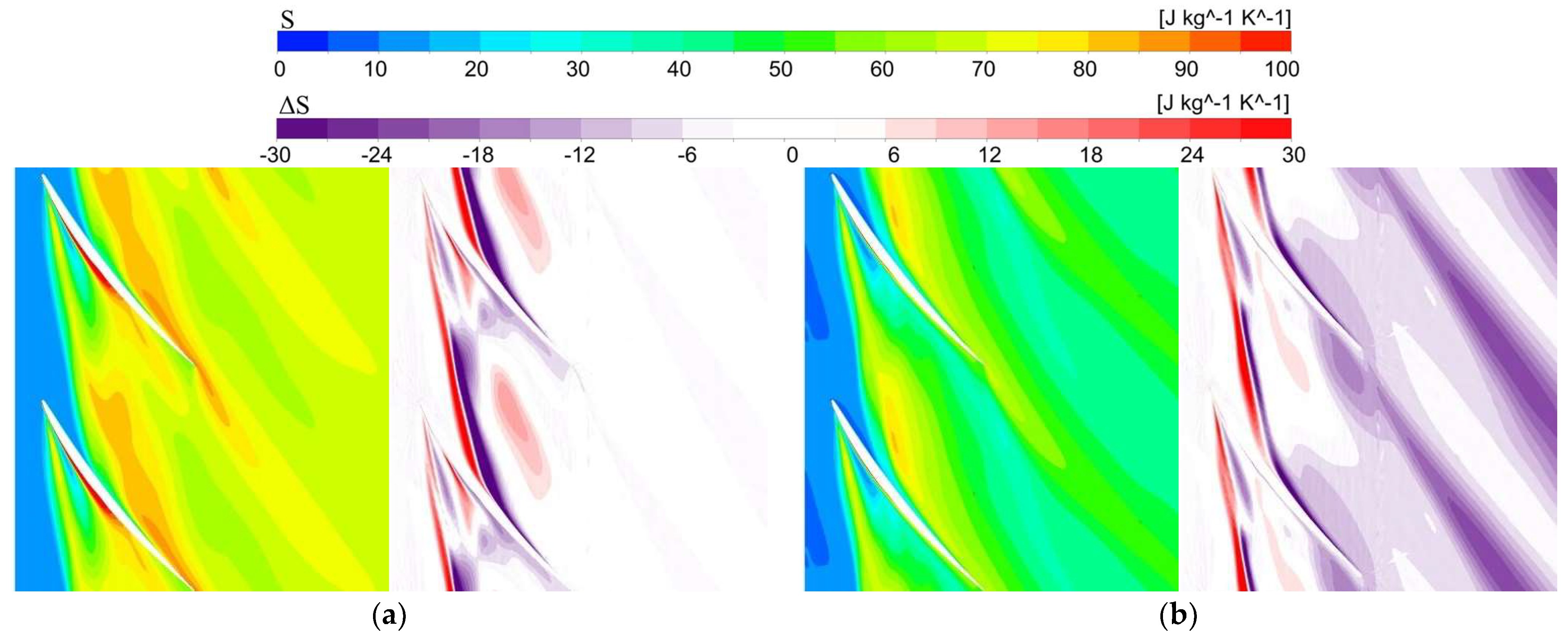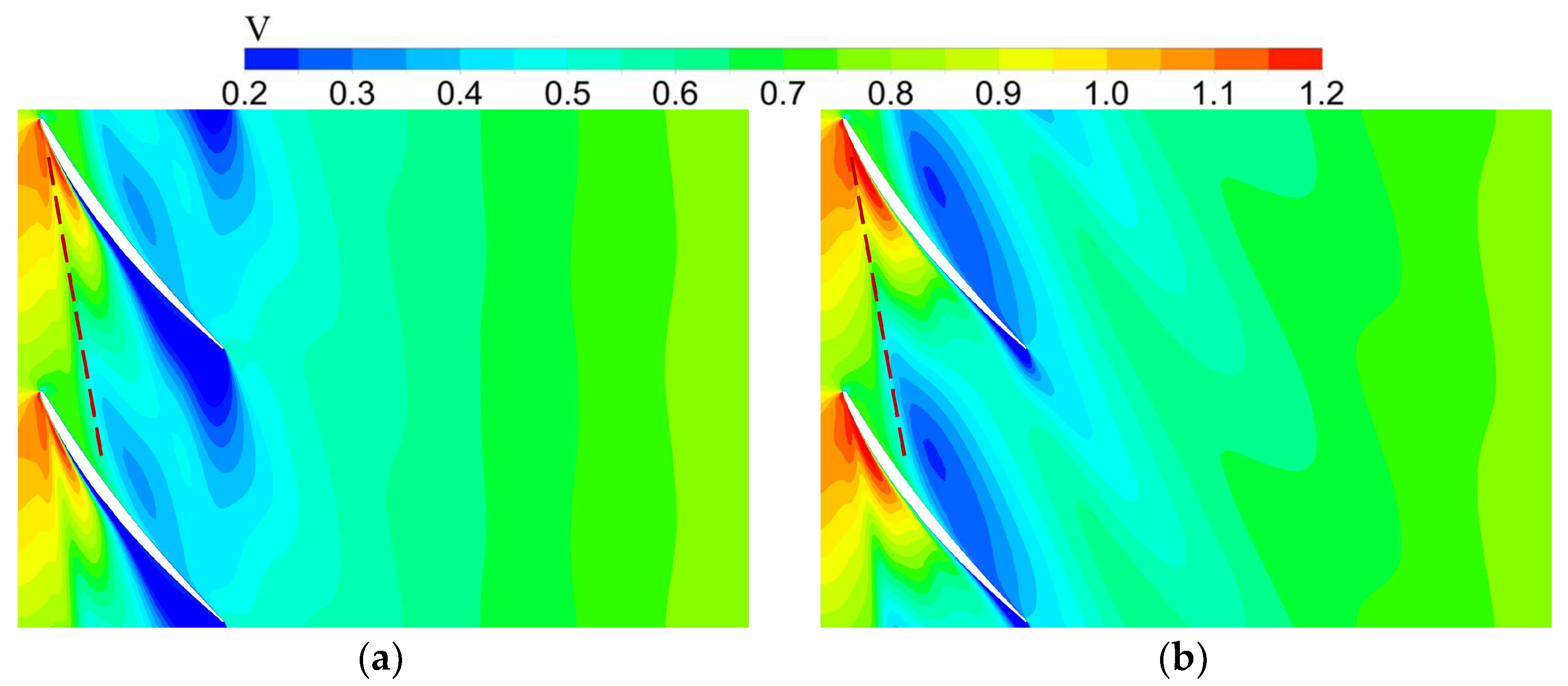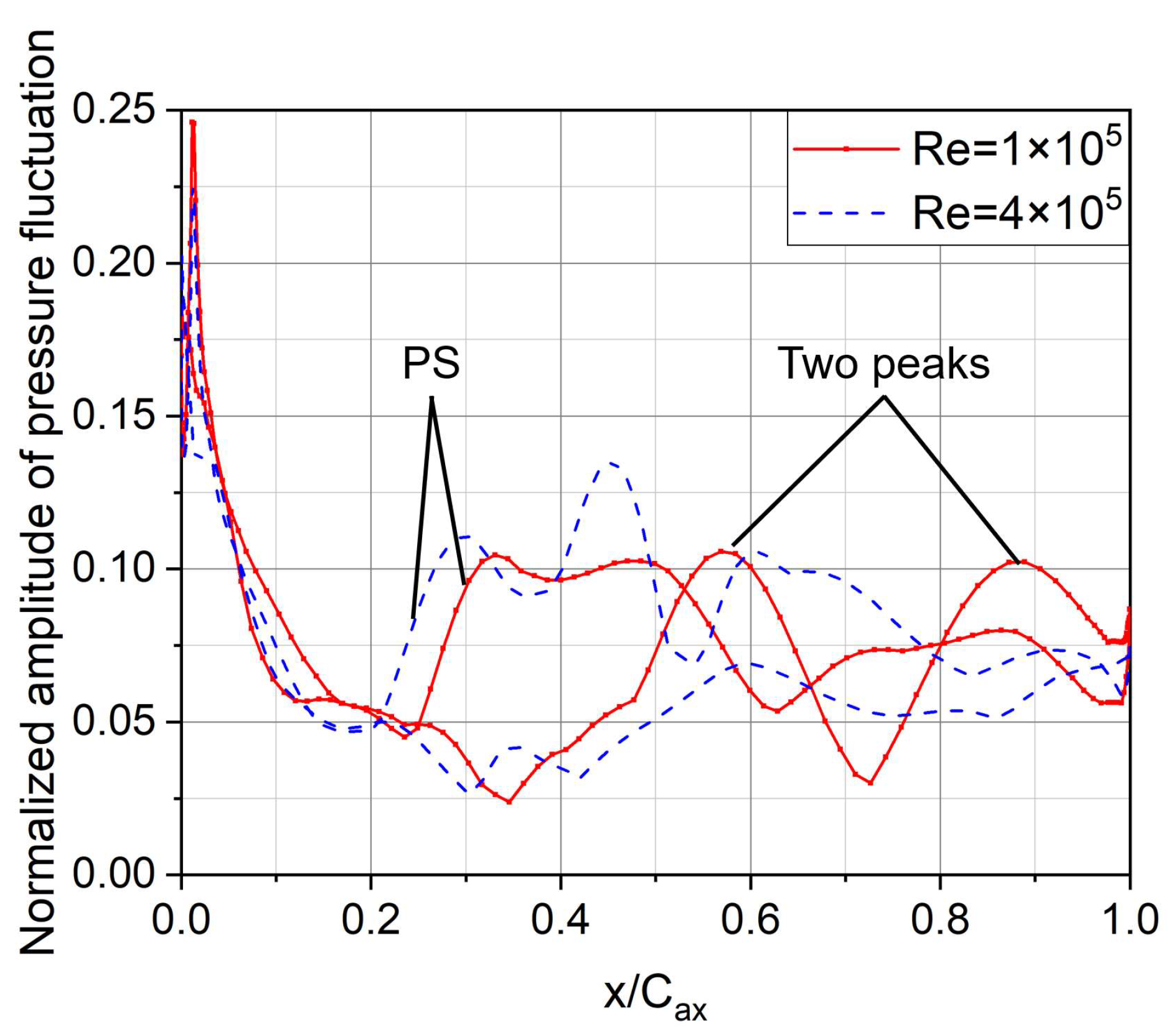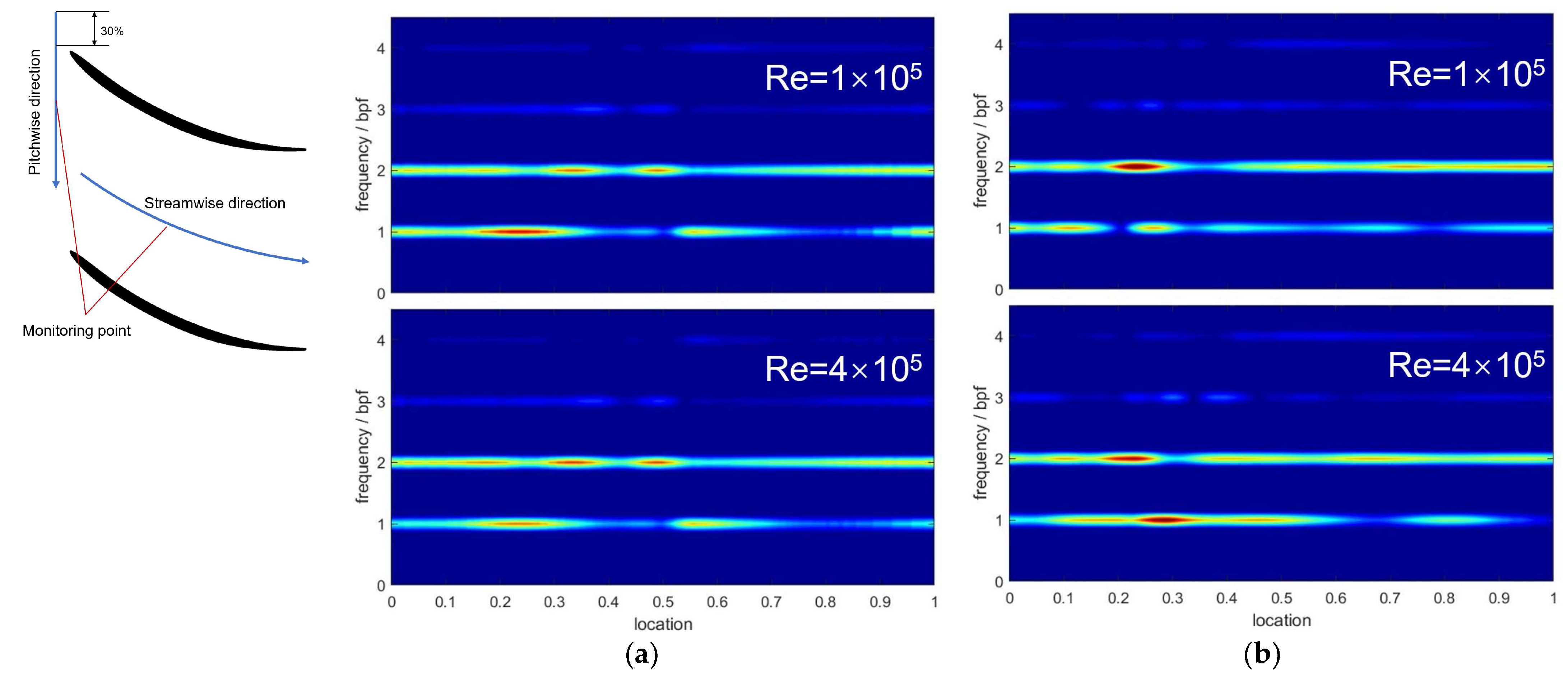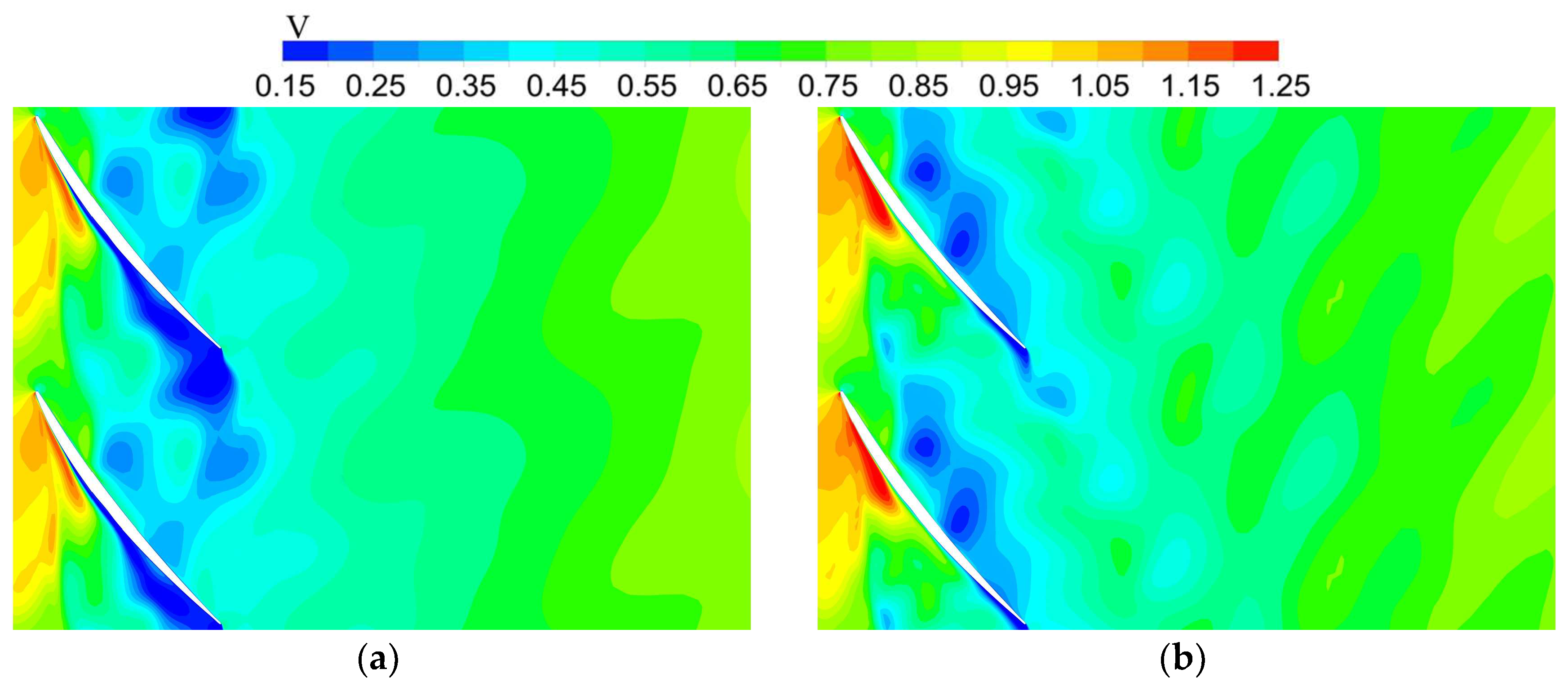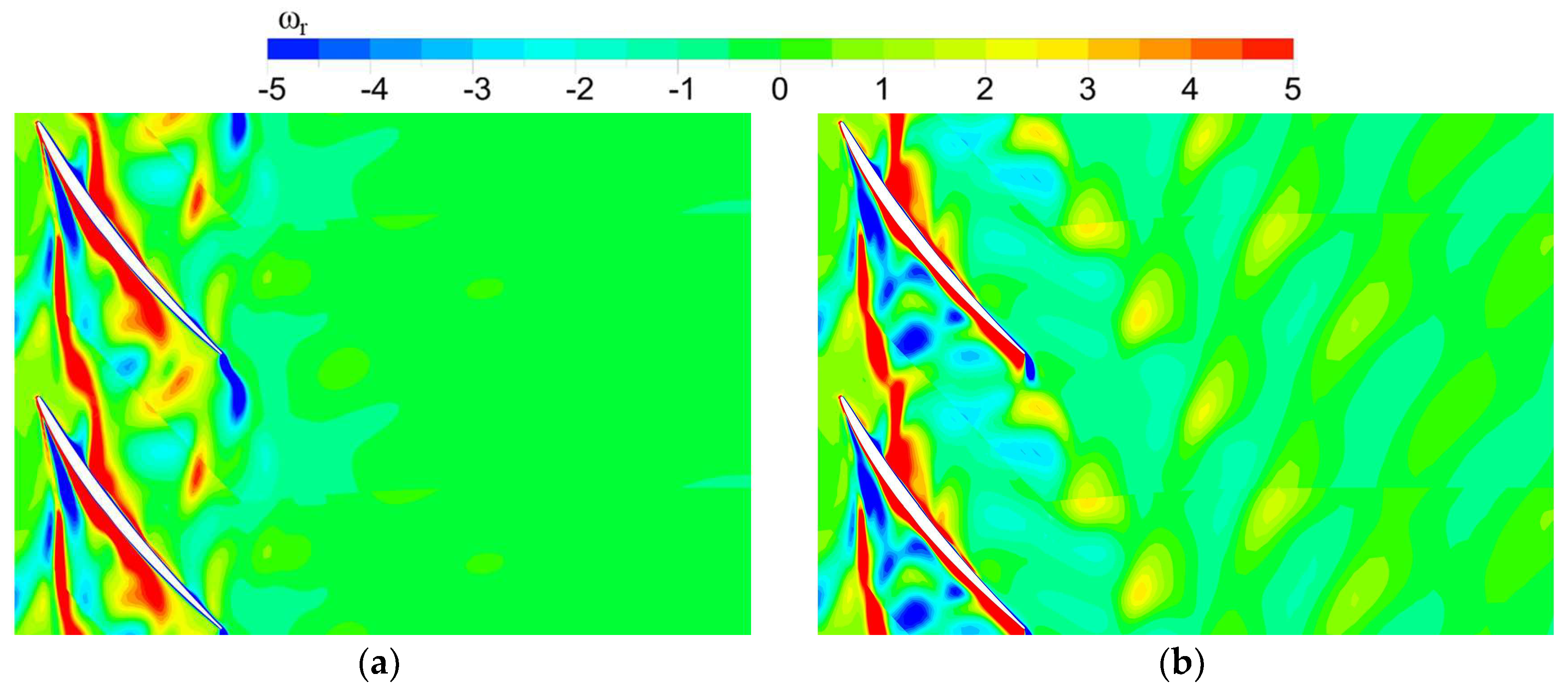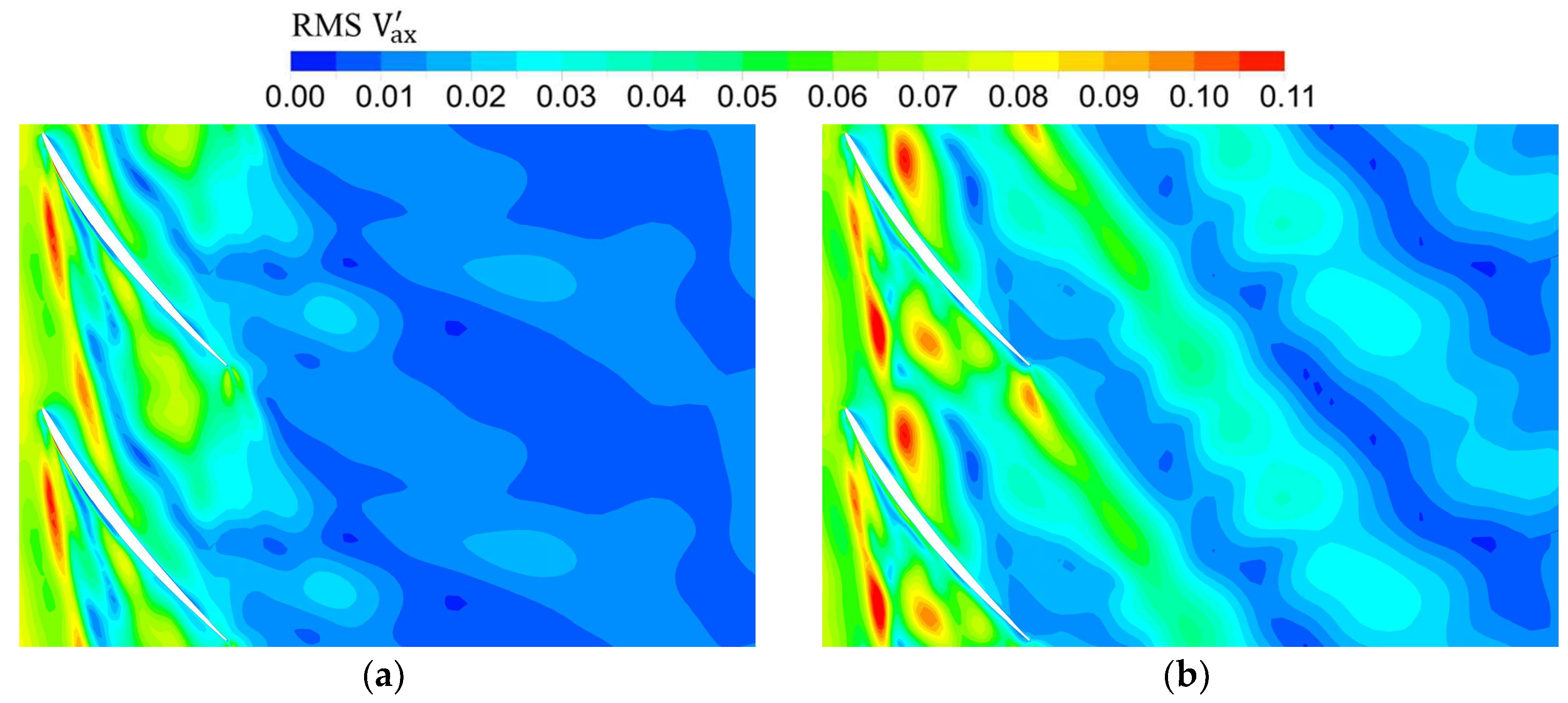3.1. Effect of Wake on Compressor Performance at Different Re
Eight cases with and without a wake were calculated at Re values from 1 × 10
5 to 4 × 10
5. The corrected mass flow and the corrected rotating speed of different cases remained the same. Because unsteady numerical simulations were used in the cases with the wake, many related results presented here have been time averaged. Based on Equation (1), the isentropic efficiency of the rotor with and without the wake at different Re is shown in
Figure 6. Clearly, both the Re value and wake influence the rotor efficiency. The rotor is less efficient and the efficiency declines sharply at lower Re, which indicates that the Re effect is significantly enhanced at low Re, resulting in a large change in the flow characteristics and performance of the compressor. By comparing the operating conditions with and without wake, it can be seen that the change of Re will make the impact of wake on performance different. The unsteady wake has a beneficial effect on the efficiency of the rotor at Re = 4 × 10
5, but this effect weakens as Re decreases until the effect is negative.
To quantitatively analyze the flow loss in different regions, the blockage coefficient of 10% chord length section after the rotor under different conditions is shown in
Figure 7. The blockage coefficient is defined by Yu et al. [
37] as
where m
b and m
t are respectively the reduced mass flow due to the flow blockage and the actual total mass flow; V is the streamwise velocity; V
ext is the average streamwise velocity at the boundary of the blockage region; A is the total area of the blockage region. According to Equation (2), the key to obtaining the blockage coefficient is to determine the blockage region. Khalid et al. [
38] proposed a method to identify blockage regions based on velocity density flow gradient, which is defined as
where V is the streamwise velocity, and r and θ are respectively the radial direction and circumferential direction. Through the test, the blockage is not sensitive to the change of the constant, and the constant is chosen as 100. The blockage region of the rotor outlet is divided into three parts by radius. The blockage coefficient of all regions decreases with increasing Re, which is consistent with the change in rotor efficiency. The flow blockage in the tip region is dominant for all cases. For the cases without wake, although the flow blockage coefficient of the hub endwall region increases rapidly with the decrease of Re, it is still weaker than that of the tip and mainflow regions. However, the flow blockage coefficient of the mainflow region is lower than that of the hub endwall region for the cases with the wake. In the mainflow and hub endwall regions, the wake has the opposite impact. The unsteady effect of the wake can reduce the flow blockage caused by the blade in the mainflow region but increase the flow blockage caused by the hub boundary layer in the hub endwall region. In addition, the effect of the wake on the blockage coefficient of the tip region will change under different Re. The flow blockage is most severe in the tip region, and it is weakened by the wake only at the Re of 1 × 10
5 and 2 × 10
5. The difference in variation trend is mainly caused by the difference of flow characteristics at different Re.
As shown in
Figure 8, the axial velocity density flow of 10% chord length section after the rotor at the Re of 1 × 10
5 and 4 × 10
5 is compared to analyze the distribution of flow blockage in detail. As mentioned above, three blocked regions can be distinguished by radius. The tip region is affected by the tip leakage flow, so there is an area of low-density flow in the whole pitchwise direction. In contrast, the range of flow blockage at the hub endwall is concentrated downstream of the blade hub due to the absence of hub clearance. In the mainflow region, the flow blockage is mainly caused by the low-velocity fluid in the wake. Comparing the density flow at different Re, the blockage and flow loss increase as Re decreases from 4 × 10
5 to 1 × 10
5 due to the increase of viscous dissipation. The influence of the wake is more obvious at the Re of 1 × 10
5, which leads to the increase of flow blockage behind the tip clearance and the decrease of flow blockage behind the blade. The change in density flow with the influence of the wake is following that of the blockage coefficient in
Figure 7, and the above phenomenon indicates that the flow structure of the blade boundary layer and tip leakage flow change obviously under the influence of the wake. In addition, because of the unsteady effect caused by the wake, there is some circumferential nonuniformity of density flow in the mainflow region. Considering the representativeness of the mid-span and the characteristics of the leakage flow at the blade tip, subsequent analysis will focus on these two blade heights.
Figure 9 shows the static entropy distribution with wake of a 10% chord length section after the rotor. The static entropy can quantitatively reflect the flow loss in the compressor. The difference in static entropy is calculated by subtracting the case without the wake from that with the wake. The unsteady effect of the wake on the flow field can be directly determined from the contours of the difference between the URANS and RANS results. For all cases, a high-entropy region appears near the shroud and behind the blade, but the high-entropy region near the hub is small. At Re = 4 × 10
5, the difference in entropy shows that the wake causes the entropy to decrease in the regions mentioned above, although there is an increase at the top of the mainflow region. Decreasing Re from 4 × 10
5 to 1 × 10
5 changes the contours of the entropy difference, except near the hub. The Re only affects the magnitude and range of the entropy reduction near the hub. With Re = 1 × 10
5, the entropy behind the suction surface (SS) increases under the influence of the wake on the suction surface boundary layer. The magnitude and range of the entropy-reduction region behind the pressure surface (PS) increase, indicating the enhanced effect of the wake. Contrary to the conclusion at Re = 4 × 10
5, the wake can increase the entropy near the shroud at Re = 1 × 10
5.
According to the above analysis, it can be concluded that the unsteady effect of the wake has a more significant impact on the flow field at the tip and mid-span of the blade. The following sections analyze these two regions in turn.
3.2. Effect of Wake on the Mid-Span Flow Field at Different Re
The rotor section at 50% spanwise height is now investigated in detail to obtain the flow field information in the mainflow region. The circumferential distribution of inlet normalized axial velocity at different Re is shown in
Figure 10. The axial velocity deficit represents the wake strength, and the wake becomes stronger and wider as Re decreases. Therefore, at low Re, the unsteady effects caused by a stronger wake are more obvious, and the influence on the downstream rotor characteristics is greater.
At low Re, the structure of the LSB keeps the pressure constant. As Re increases, the region of constant pressure decreases in size and has less influence on blade loading. The wake-induced boundary layer transition affects the size of the separation bubble, which is an important factor affecting the loading and performance of the rotor.
Figure 11 shows the skin friction coefficient (C
f) on the suction surface of the blade, from which the length of the LSB can be obtained. The positions at which C
f = 0 represent the points of separation and reattachment of the LSB. For the results with the wake, a decrease in Re causes the position of turbulent reattachment to move back and that of laminar separation to move forward. However, for the cases without the wake, the position of the boundary layer separation does not change with Re. By comparing the results with and without the wake, it can be concluded that the wake suppresses laminar separation and promotes turbulent reattachment at high Re but delays turbulent reattachment at low Re. Under the influence of wake, the length of the LSB increases at low Re and decreases at high Re. The flow loss caused by the LSB also changes with its length. The wake can input energy and disturbance to the boundary layer to affect its development. In addition, the process of wake-induced transition also indirectly affects the location of turbulent reattachment.
To analyze the detailed flow field within the boundary to obtain the boundary development process,
Figure 12 shows the contours of the normalized mainflow velocity on the suction surface, where the dotted line indicates the displacement thickness of the boundary layer. The mainflow velocity is the velocity along the tangent line of the blade surface. In
Figure 12, the horizontal axis x/C
ax is the normalized length along the blade surface, and the vertical axis y/C
ax is the normalized normal distance from the blade surface. The low-velocity region caused by the boundary separation can represent the position and size of the LSB. The low-velocity region increased significantly as the Re decreased from 4 × 10
5 to 1 × 10
5. The thickest position of the LSB is 0.5C
ax, and the thickness of the LSB gradually decreased. The LSB in the case without wake disappears at 0.65C
ax, but the wake can prevent the LSB from disappearing. In addition, the displacement thickness of the boundary layer thickens rapidly with the appearance of flow separation bubbles, which block the flow passage and increase the loss. In addition, the boundary layer develops into turbulent flow after reattachment, and the continuous increase in its thickness leads to a large loss due to turbulent viscosity dissipation. As Re decreases, the ability of the boundary to resist separation weakens, and the transition process is delayed, such that the length and thickness of the separation bubble increase. It is also clear that the thickness of the boundary layer increases with decreasing Re. Considering the influence of the wake, the boundary layer thickness decreases slightly at high Re and increases significantly to form an open separation bubble at low Re.
Figure 13 shows the distribution of suction surface boundary layer momentum thickness (θ) and shape factor (H
12) at different Re. θ represents the magnitude of the loss of momentum caused by the viscous boundary layer. The turning point in the curve of θ indicates that the instability of the boundary layer is suddenly magnified, followed by a rapid increase in the loss of momentum. The reason for this phenomenon is the boundary layer transition, with the turning point representing the transition point. As Re decreases, the turning point of θ moves downstream and its growth rate increases after the turning point. A faster momentum thickness growth rate indicates stronger turbulent dissipation. The wake causes the turning point to move downstream at Re = 4 × 10
5, but the wake no longer changes the turning point and only increases the growth rate of θ after the turning point at Re = 1 × 10
5. H
12 represents the velocity pattern of the boundary layer and reflects the separation and transition phenomena. A larger value of H
12 indicates more obvious boundary layer separation at Re = 1 × 10
5. By comparing H
12 in the cases with and without the wake at Re = 1 × 10
5, it is apparent that the position before the maximum thickness of the separation bubble is not affected by the wake. However, the wake can increase the separation size of the turbulent boundary layer after the transition. The difference in H
12 is consistent with the changes in momentum thickness, and the region affected by the wake at Re = 1 × 10
5 is the turbulent boundary layer after the transition. At Re = 4 × 10
5, the change in momentum thickness indicates that the wake advances the boundary layer transition. Therefore, the ability of the boundary layer to resist separation is enhanced, and the size of the boundary layer separation is reduced. There is a significant decrease in H
12 over the entire separation bubble region.
A series of time-dependent data are obtained by setting monitoring points along the line of the blade suction surface at 50% span. To explore the development of the boundary layer at the wall induced by the periodic wake, three passage periods of the rotor are selected and the phase-locked average results are calculated to obtain the space-time diagram on the suction surface at 50% span. The space-time diagram of the normalized axial velocity is shown in
Figure 14. The axial velocity of the first mesh layer on the wall is used to represent the state of the boundary layer separation. As there is backflow in the LSB, the position at which the boundary layer starts to separate is represented by a near-wall velocity of zero, and the region with a negative near-wall velocity represents the boundary layer separation region. At Re = 4 × 10
5, the boundary layer is disturbed by the wake, and the starting point of separation changes continually. At a certain time, the LSB appears, and the position of turbulent reattachment moves downstream. The starting position of separation then shifts downstream until the LSB has completely disappeared. At Re = 1 × 10
5, the position of boundary layer separation fluctuates periodically under the wake effects. The sweep of the wake also causes the LSB to fall off at the tail and then move downstream with the wake. When the detached separation bubble moves to the trailing edge of the rotor, its ability to resist separation is relatively weak. Therefore, a large region of turbulent separation forms at the trailing edge. At Re = 4 × 10
5, the transition occurs closer to the leading edge of the blade, and the boundary layer flow is completely turbulent after reattachment. The turbulent separation is less affected by the wake and does not change with time. Instead, turbulent separation occurs periodically due to the effect of the wake at Re = 1 × 10
5.
A vector diagram of the transient disturbance velocity and contours of the normalized transient disturbance vorticity at the same time are shown in
Figure 15. There is a prominent reverse vortex downstream of the wake, which slows the flow of the boundary layer and generates small-scale vortices that affect the boundary layer. Forward and reverse vortices appear alternately, which accelerate and decelerate the boundary layer flow, respectively.
Figure 16 shows the transient intermittency contours at the same time to indicate the flow status. Intermittency values of 0 and 1 represent fully laminar flow and fully turbulent flow, respectively. The transition process is caused by the instability of the boundary layer. There are two main types of viscous instability: Tollmien–Schlichting and inviscid K-H. The main phenomena of the transition caused by the K-H instability are vortex rolling, shedding, pairing, and crushing, resulting in a strong mixing and momentum exchange between the boundary layer and the mainflow region. In general, the dominant instability type is affected by the boundary thickness, and the separation boundary layer mainly exhibits K-H instability. At the position of the separation bubble, the region where the intermittency factor changes significantly near the mainflow region is caused by the K-H instability. With boundary layer reattachment, the K-H instability disappears. The K-H instability induced by the wake dominates the transition process in the separated shear layer.
Figure 15 and
Figure 16 indicate that the reverse vortex moves upstream with decreasing Re, leading to an expansion of the region of influence of the wake and the induced transition region. The vortex intensity is relatively weak, and the derived vortex has a smaller influence range at low Re. However, the number of derived vortexes is greater than that at high Re. In the case of high Re, the area of vortex concentration is closer to the blade due to the thicker boundary layer. Compared with the result at Re = 1 × 10
5, the K-H instability induced by the wake develops more rapidly at Re = 4 × 10
5 due to the higher vortex intensity. As the wake moves downstream, the transition process caused by the K-H instability accelerates under Re = 1 × 10
5. Therefore, the region of transition near the blade trailing edge decreases significantly. With Re = 4 × 10
5, the K-H instability is weakened by the reattachment of the LSB. Therefore, the transition process decelerates, and the transition region near the blade trailing edge becomes larger.
3.3. Effect of Wake on the Tip Flow Field at Different Re
According to the analysis in
Section 3.1, the upstream wake and TCV have strong unsteady effects, which in turn influence the compressor performance. The unsteady interaction varies with Re. The contours of the static entropy with wake and its difference with no wake at 99% span are shown in
Figure 17, illustrating the influence of the wake on the flow loss of the tip flow field. The calculation method of the difference in entropy is consistent with
Figure 9. For the result with the wake at Re = 4 × 10
5, the high-entropy region is concentrated in the region influenced by the TCV and develops from the suction side leading edge across the flow passage to the pressure surface of the adjacent blade. According to the difference in entropy at Re = 4 × 10
5, there is a strip in which the entropy is increased by the interaction in front of the TCV. Although the direct mixing effect caused by the wake rapidly increases the entropy, the unsteadiness of the wake changes the TCV intensity by influencing the blade loading, resulting in a reduction in flow loss because of boundary layer separation at the trailing edge. As the entropy reduction outweighs the entropy increase, the flow blockage becomes weaker at the tip region. In the case of a wake with Re = 1 × 10
5, the high-entropy region has a greater range over the whole flow passage, except at the inlet, indicating that the flow loss caused by the TCV increases sharply at low Re. As Re decreases from 4 × 10
5 to 1 × 10
5, the entropy difference shows that the mixing loss caused by the wake and TCV remains almost unchanged, but the range of entropy reduction in the TCV core region becomes larger. The magnitude and range of the entropy reduction behind the blade decrease significantly, indicating that the beneficial effect of the wake on the flow loss has decreased. In addition, there is a region in which the entropy increases in the center of the flow passage. This is because the intensity of the double-leakage flow increases under the influence of the unsteadiness at Re = 1 × 10
5.
The strength of the TCV is affected by the tip loading distribution. To determine the strength and position of the TCV under the influence of the wake,
Figure 18 shows the distribution of the static pressure coefficient at 99% span and the mass flow rate of the tip leakage flow distribution at different Re. The mass flow rate distribution of the tip leakage flow is the axial distribution of the average velocity times density along the tip clearance height. The compressor blade is a front-loading type, so the maximum loading position is located at the leading edge. The large leakage flow region ranges from 10% to 30% of the axial position and corresponds to the high-loading region. Due to the large incidence, the pressure coefficient of the pressure surface drops sharply at the leading edge and then gradually increases until the 20% axial position. After the turning point, the increase in the pressure coefficient on the pressure surface slows down; this position is the same as the maximum leakage flow position. The leakage flow fluctuates before the 50% axial position, mainly because of fluctuations in the loading on the suction surface. After the 50% axial position, the static pressure coefficient of the suction and pressure surfaces starts to rise steadily, and the leakage flow exhibits a corresponding steady decline. Comparing the calculation results at different Re, we find that the pressure coefficient on the pressure surface decreases slightly with decreasing Re. The pressure coefficient on the suction surface increases slightly at the front part of the blade and decreases slightly at the back. The change in the loading distribution leads to a decrease in the tip leakage flow at the front of the blade and an increase at the back at Re = 1 × 10
5.
Figure 19 shows the time-averaged relative velocity contours at 99% span, with the average relative velocity of the rotor inlet adopted for normalization. The velocity of the TCV is lower than the mainflow velocity, resulting in a large low-velocity region and flow blockage in the tip flow field. As the TCV causes a sharp decline in the velocity of the mainflow, an obvious dividing line (dashed line in
Figure 19) occurs at its front, and there is a large velocity gradient along this dividing line. Comparing cases at different Re, we see that the TCV intensity at low Re is relatively weak, and the range of the low-velocity region diffusing to the trailing edge of the adjacent blades’ pressure surface is smaller. When the TCV diffuses to the trailing edge region of the adjacent blades’ pressure surface, a double-leakage flow is generated at the blade tip. The double-leakage flow crosses the tip clearance, interacts with the suction surface boundary layer, and mixes with the wake caused by the separation of the rotor boundary layer. It can also be seen that the low-velocity region generated by the interaction between the double-leakage flow and the rotor boundary layer is significantly affected by the Re, and the range of the low-velocity region increases significantly at Re = 4 × 10
5. The reason is that the ability of the fluid to resist separation is weak at low Re. Although the strength of the TCV is weak, the slight disturbance of the double-leakage flow still leads to boundary layer separation over a significant range and a large low-velocity region. For Re = 4 × 10
5, the interaction between the double-leakage flow and the boundary layer at the trailing edge of the rotor is weak, so its effect on the flow field is not obvious, and only a small low-velocity region is generated.
The TCV interacts with the upstream wake in the development process. As shown in
Figure 20, the amplitude of pressure fluctuations on the rotor surface at 99% span is selected for comparison. The difference between the maximum and minimum pressure at different times gives the amplitude, with the average static pressure at the rotor inlet used for normalization. The amplitude of pressure fluctuations at the leading edge of the pressure surface is large because of the influence of the incoming flow wake and TCV, and then gradually decreases until the 25% axial position. As the TCV reaches the pressure surface across the flow passage, the amplitude of the pressure surface fluctuation increases again due to the strong disturbance of the TCV. The leading edge of the suction surface exhibits similar behavior to the pressure surface, and the amplitude of pressure fluctuations decreases until the 35% axial position. The amplitude on the suction surface exhibits different trends at different Re. For the low Re condition, the double-leakage flow and boundary layer separation produce two local peaks in the fluctuation amplitude on the suction surface, and these peaks are significantly larger than the fluctuation amplitude at Re = 4 × 10
5. However, at Re = 4 × 10
5, the fluctuation amplitude on the suction surface only increases slightly under the influence of the double-leakage flow. The pressure fluctuation amplitude on the pressure surface is more obviously affected by the TCV at Re = 4 × 10
5, which is larger than that of the suction surface and is greater than the pressure fluctuation amplitude at Re = 1 × 10
5. In conclusion, the pressure unsteadiness is mainly caused by the wake, TCV, and double-leakage flow at low Re, which are mainly located at the leading edge, 30–50% axial position of the pressure surface, and 50–100% axial position of the suction surface.
To quantify the unsteady pressure fluctuation in the tip flow field induced by the wake, the pressure signal from the time domain is converted into the frequency domain via fast Fourier transform (FFT). As shown in
Figure 21, the monitoring points used for FFT are extracted along the streamwise direction inside the rotor and along the pitchwise direction at the rotor inlet.
Figure 21 shows the amplitude-frequency characteristics of the monitoring points at 99% span. For the unsteady perturbation in the tip region, blade passage frequency (BPF) and 2BPF are dominant, while the amplitude of 3BPF and 4BPF is relatively small. Along the pitchwise direction at the rotor inlet, the influence range of 2BPF is the largest. Due to the interaction between the TCV at the leading edge and the wake, three regions with a large amplitude of 2BPF and one region with a large amplitude of BPF are located near the blade. There is also a large amplitude region of BPF at 0.5 to 0.7 normalized pitchwise length, but this region does not change at different Re. With the Re decreasing from 4 × 10
5 to 1 × 10
5, only the amplitude of BPF near the blade increases slightly. Along the streamwise direction, the amplitude of BPF and 2BPF increases rapidly, which is induced by the rapid development of the unsteady tip leakage flow. Subsequently, the influence of BPF weakens, while 2BPF is still dominant in the flow field. Comparing the results of different Re, it is found that the influence range and amplitude of 1BPF are larger at high Re.
In general, there are two kinds of interaction between the wake and TCV. First, the wake of the IGV generates a negative jet disturbance, which directly interacts with the TCV in the tip region, resulting in strong unsteady effects. Second, the wake periodically changes the loading distribution, thus indirectly affecting the strength and position of the TCV.
Figure 22,
Figure 23 and
Figure 24 show characteristics of the transient flow field at the same time under different Re conditions. The normalized relative velocity, normalized radial vorticity, and root mean square of the normalized axial velocity disturbance are selected for comparison. These flow parameters distinguish the mainflow and secondary flow phenomena, such as the wake and TCV, allowing their interaction mechanism in the flow field to be identified. The normalized radial vorticity is defined as
where ω
0 is the radial vorticity, C
ax is the axial chord length of the blade, and V
in is the time-averaged relative velocity at the rotor inlet. The other two velocity parameters are normalized by V
in. The transient relative velocity contours are shown in
Figure 22, where the TCV is divided into multiple low-velocity regions. As Re decreases, the range of each low-velocity region becomes smaller. At Re = 1 × 10
5, the unsteady interaction between the double-leakage flow and the suction surface boundary layer causes a wide low-velocity region to appear near the trailing edge. This region also presents multiple parts, causes a large flow blockage, and directly contacts the TCV on the pressure surface, which makes the tip flow field deteriorate sharply. In addition, the low-velocity region changes the shape of the rotor wake. The wake of the rotor no longer propagates downstream, and the low-velocity region caused by boundary layer separation and the double-leakage flow cover the whole outlet. However, the double-leakage flow only affects a small part of the trailing edge at Re = 4 × 10
5, resulting in a low-velocity region. This region mixes with the rotor wake and flows downstream.
Figure 23 shows the radial vorticity contours, which can indicate the position of the interaction between the wake and TCV. The negative vorticity introduced by the wake is truncated by the tip leakage flow. At Re = 4 × 10
5, the wake propagation path changes after it passes through the TCV. Subsequently, the wake continues to influence the flow field behind the TCV, which inhibits the action of the double-leakage flow and hinders the development of the boundary layer separation. At Re = 1 × 10
5, the wake dissipates and mixes with the TCV. The dissipation of the wake caused the amplitude of 1BPF at Re = 1 × 10
5 to be smaller than that at Re = 4 × 10
5, as shown in
Figure 21. The influence of the wake after the TCV is greatly weakened, and the double-leakage flow becomes the dominant factor controlling the flow field. In addition, although the rotor wake vortex is stronger at low Re, it stops propagating downstream due to the interaction with the boundary layer separation. Therefore, there is no interaction between the IGV wake and the rotor wake downstream of the rotor.
Figure 24 shows the root mean square of the axial velocity disturbance, representing the intensity of unsteadiness caused by the TCV and wake. The wake region and TCV region are the main fluctuation regions in the blade tip flow field, but the interaction between the wake and TCV varies with the Re value. There are two disturbance core regions at Re = 1 × 10
5, while there are three disturbance core regions at Re = 4 × 10
5. The difference is mainly caused by variations in TCV strength and loading distribution. At Re = 4 × 10
5, the wake passes through the TCV and interacts with it strongly, resulting in an obvious disturbance region downstream of the TCV. However, the large suction surface separation caused by the interaction between the double-leakage flow and boundary layer at Re = 1 × 10
5 is an important factor in the flow field disturbance.
